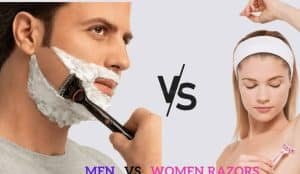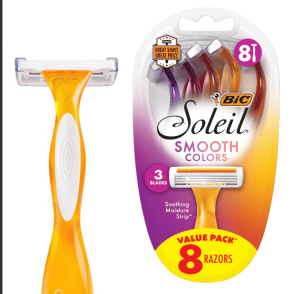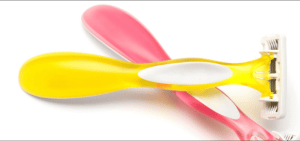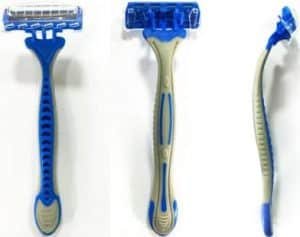Share this
Last Updated on by Sharon Olabanji
For years, women and men have bought separate razors with aggressively macho or feminine packaging. However, razor companies have challenged the shaving status quo in recent years. Is there a distinct difference between razors for males or females, or are there unisex razors for both genders?
New developments, research, and studies on razor use have led people, especially women, to ask; Can a girl use men’s razors for shaving? Venus conducted a survey and discovered that 30% of women use a razor designed for males.
Yes, we have numerous female friends who believe that their boyfriend’s razor is superior to their own, but they have never received such advice from a professional dermatologist or hair-removal expert.
Bornfertilelady brings to you a lot of things you need to know concerning razors. Borrowing someone else’s razor might sound convenient, but there are design and hygienic reasons why sharing razors isn’t a good idea, especially between genders.
As well as discovering why you shouldn’t share a razor for design and sanitary reasons, plus, learn a few tips for how to avoid the need to share razors in the first place.
Alright, we move!
Men’s vs. Women’s Razor Features

First, let’s break down the areas where men’s and women’s razors differ. Then we’ll be able to see if those distinctions are meaningful, or just marketing. Here we go;
Color

The most telltale sign of a men’s or women’s razor is the color. Women’s razors nearly always appear in feminine colors, such as pink, purple, or a range of pastels.
Men’s razors come in traditionally masculine shades like blue, black, or silver. If you wanted a men’s razor in pink, you’d be hard-pressed to find one.
The color of the razor has no impact on the effectiveness of the razor (although as we move through the other features, you’ll find that the color coding is firm enough that color will often indirectly correspond to features).
Heads

While anyone can shave any body part with any razor, people tend to use razors in gendered ways. When women shave, they’re often navigating different parts of the body than men are. The approach a man uses to shave his face may not work as well on a woman’s underarms or legs.
Razor heads take that into account. On a woman’s razor, you’ll find a more rounded head, which can easily navigate contours like an armpit or the back of a knee. The square heads of men’s razors are better suited to the shape of the face.
This aspect of the razor definitely impacts performance. A wide paddle-like head with a ring of moisturizing compound might be just perfect for shaving your legs, but a complete pain to use to shave facial hair on account of how unwieldy the larger head is.
Blades

Men’s and women’s razors generally have the same kinds of blades, and you can find similar numbers of blades in each razor type. However, the blades have different angles.
Men’s razor blades have a greater angle, so they’re better positioned to cut through dense facial hair. Women’s razors don’t need the same angle to get through softer body hair. In fact, the blade exposure of a men’s razor can lead to more cuts if a woman uses it on her body.
The blades on women’s razors also get dull faster, since they use them to shave much larger areas. This means that in addition to paying more for razors, women must replace their razors or blades more often.
Handle Shape

Because men and women tend to shave different areas, their razors also have different handles. Women’s razor handles have a rounded shape that’s easy to grip from all angles.
Women need to change the position of their razor grip more often to reach different body parts. A man doesn’t need to grip his razor in as many positions if he’s just shaving his face.
Handle Arc

In addition to differences in the grip of the handle, the handle curvature, or arc, is also typically different on men’s and women’s razors.
When women shave areas like their legs, bikini, and armpits, it’s important that they can see what they’re doing without their hand or the body of the razor getting in the way. Women’s razors usually have a bigger arc so the head of the razor won’t block their view.
Men’s razors have a flatter shape, usually with zero arcs to the handle because the way you hold the razor when shaving your face while looking in the mirror doesn’t require it.
Lubrication

Finally, women’s razors usually have built-in lubrication, whereas most men’s razors don’t (or have a very small lubrication strip).
This lubrication can come in different forms, like bars of shave lotion that sit around the head like a donut or gel strips around the blades.
These features help protect from cuts when shaving around the contours of the ankles, knees, and other sensitive areas. The lubricating strips are useful, but the razor typically outlasts the strip, so they are only good for the first shaves.
So, What’s the Difference Between Men’s and Women’s Razors?
Like many other products, razors often reinforce the gender binary through color stereotypes. Pink or other pastels for women; some combination of blue, gray, and orange for men.
The differences between men’s and women’s razors don’t stop at color, but it’s less about the gender identity of the person wielding the razor and more about what they’re shaving.
Women’s razors are designed for people shaving legs, armpits, and pubic areas. Since that adds up to a considerable amount of surface area, the head of a women’s razor is often a little larger than the one on a men’s razor.
It’s also often rounded, so you can more easily navigate it around contours like ankles and knees. The handle might be rounded, too, or shaped in some other nonlinear way with grooves that help you keep a good grip on it throughout the process.
“When you think about all the ways women have to hold a razor to reach those tricky spots and then add in a shaving gel or soap and water in the shower—things can get slippery. It’s no wonder women need a different kind of handle,” dermatologist Dr. Jody Levine, who’s also a spokesperson for Gillette and Venus, told Reader’s Digest.
Women’s razors also sometimes have two lubricating strips, above and below the blades, to moisturize the skin and prevent nicks when quickly shaving such a large region.
Men’s razors, on the other hand, are mainly intended for people shaving their faces. Contrary to popular belief, men’s razor blades aren’t usually any sharper or higher-quality than women’s blades.
But according to Today I Found Out, they’re more closely packed together in a razor head—the better for cutting through coarse facial hair and getting as close to a shave as possible.
The smaller, squared head helps people be precise about which parts of their facial hair they’re shaving off.
That said, there’s no shortage of variation when it comes to razor design, and it’s definitely not one-size-fits-all. If you think the advantage of tightly packed blades outweighs the disadvantage of a smaller head when shaving your legs, by all means, opt for a “men’s” razor. It’s probably cheaper, anyway.
So, Can a girl use men’s razors?

So, is it OK for women to use men’s razors? – You might be wondering. You shouldn’t share a razor with anyone, female or male. You can use a male razor for touch-ups and shaving facial hair, but when it comes to shaving larger areas of the body, consider a women’s razor.
Men’s razors are usually designed with facial hair in mind; but women may shave up to 10 times more surface area than men — for instance, legs, underarms, and the bikini area — so women’s razors are designed to shave these large areas in a single session.
Many women’s razor heads are more oval-shaped vs. square to easily shave tighter areas like underarms. While they come with the same sharp blades as male razors, they may have additional lubrication to better protect the skin when shaving larger areas like legs.
And, since body-shaving often requires gripping the handle in multiple positions, razor handles made for women are typically easier to grip in a variety of positions.
Why shouldn’t I share my razor or borrow someone else’s?
You shouldn’t share a razor with someone else due to sanitary concerns. You can get nicked or cut while shaving, and if you use someone else’s razor you are putting yourself at risk for infection — and vice versa.
Moreover, you may not know how long someone else’s razor has been used. His or her razor could be older than you think, and shaving with a dull blade increases the chances of nicks, skin irritation, razor burn, and bumps.
What are ways to prevent sharing someone else’s razor?
If you use a refillable razor, consider stocking up on blade cartridges so you don’t reach for someone else’s razor if your blade is too dull.
Having extra blades readily available will also come in handy if someone else accidentally uses your razor, so you can simply swap the used blade with a new one to avoid cross-contamination.
If you use disposable razors, keep a few extras nearby. And, consider placing an extra razor in your travel toiletry bag as well, so you don’t forget one when traveling.
Make sure your razor is also easily recognizable, especially if you live with someone else who uses a woman’s razor. Having a distinct razor can help prevent sharing with someone else by accident.
To help ensure you always know which razor is yours, consider building your own. That way, you can choose the features you want for your unique shaving needs.
And, take a moment to look through all the shaving products available, including razors, refills, trimmers, shave gels, and more.
Which Razors Should You Buy?
Most of the differences between men’s and women’s razors have a specific purpose. The only thing that’s purely marketing is the color. Of course, in addition to the different designs, women’s razors also come at a higher price point.
Whether that added cost is worth it or not depends on the individual. Many women will find that men’s razors aren’t as comfortable or effective to shave with.
Lots of men will find that women’s razors can’t chop through their dense facial hair or the shape of the razor makes it difficult to use. However, there’s no reason not to try the other side to see what you think.
Some niche brands also offer an alternative: unisex disposable razors. Another universal choice, the non-disposable safety razor, is currently experiencing a resurgence in popularity. If you’re not pleased with either gendered option, you might try one of these razor styles to get the best of both worlds.
So, Which Razors are Best for Women?
Below are 8 best razors that are suitable for women;
- Gillette Venus Deluxe Smooth Platinum Razor
- BIC Soleil Comfort 4-Blade Women’s Disposable Razors
- Schick Hydro Silk Sensitive Skin Razor
- Billie The Razor Starter Kit
- Gillette Venus Comfortglide Women’s Razor
- Alleyoop All-In-One Portable Razor
- Gillette SkinGuard Razor
- Athena Club Razor Kit
A Word of Advice from Bornfertilelady
Venus discovered that some women believe the men’s razor blades are sharper. Nevertheless, the men’s razor that they use is identical to the numerous fine female razors available, such as Venus Embrace.
Another hypothesis or theory? Some ladies like the sleek, shining, silver appearance of men’s razors and prefer to use them due to their appearance instead of functionality.
However, there are several reasons why the women’s razor versions are created differently: Women shave 18 times the surface area of males!
The oval face of women’s razors glides effortlessly, there are extra moisturizing strips, and the squishy grip stops it from slipping—all of which helps them avoid cutting up the back sides of their knees. Which do you prefer: Do you prefer a silver razor to nick-free legs?
So, regarding the aspects of shaving razors for women, women should always opt for functionality instead of design, because men’s razors are designed to be most suitable for males. In contrast, women’s razors are designed with women’s shaving needs in mind.
Men’s razors are mainly intended for people shaving their faces. Contrary to popular belief, men’s razor blades aren’t usually any sharper or higher-quality than women’s blades.
But according to Today I Found Out, they’re more closely packed together in a razor head—the better for cutting through coarse facial hair and getting as close to a shave as possible.
The smaller, squared head helps people be precise about which parts of their facial hair they’re shaving off.
That said, there’s no shortage of variation when it comes to razor design, and it’s definitely not one-size-fits-all. If you think the advantage of tightly packed blades outweighs the disadvantage of a smaller head when shaving your legs, by all means, opt for a “men’s” razor. It’s probably cheaper, anyway.
All right, guys, that is it for now for; Can a girl use men’s razors? I hope Bornfertilelady answered any questions you had concerning whether Can a girl use men’s razors.
If you still want to know more on matters related to whether Can a girl use men’s razors, you can check our FAQs section below.
And always remember that Bornfertilelady is one of the best health sites out there that genuinely care for expecting parents, and you can find valuable information on all things about prenatal care on this site.
It is founded by a pregnancy expert and a mother of two, and the platform offers resources on prenatal nutrition, including information on the best pregnancy vitamins and insightful tips on how to have a healthier lifestyle as a mom (pregnant and delivered).
Frequently Asked Questions
What happens if a girl uses a man’s razor?
In fact, the blade exposure of a men’s razor can lead to more cuts if a woman uses it on her body. The blades on women’s razors also get dull faster, since they use them to shave much larger areas.
This means that in addition to paying more for razors, women must replace their razors or blades more often.
Can I use a men’s razor to shave down there?
A female user of the Gillette five-blade razor said; “Works like a charm!” “I just use a men’s razor actually — the Gillette five-blade razor is the absolute best.” “For around that area to prevent razor bumps, I use rosehip oil or Anthony’s Ingrown Hair Treatment.”
Note: This might work for some women, but it might not work for you. It’s best to discuss with a professional hair removal expert or your dermatologist on which razor is best for you.
What is the best first razor for a girl?
Begin with a single-blade razor: Double-blade razors will get a closer shave, but single blades are less likely to cause cuts. As a result, single blades are best for beginners and should be used until they build their confidence and coordination.
Why are women’s razors better than men’s?
“The razor blade cartridge shape on women’s razors is typically different from men’s razors. The oval shape suits women’s shaving better than the square head of a men’s razor because it fits better into the curves such as behind the knee and underarms.” – Says a Professional Hair Removal Expert.
Are women’s razors better for shaving legs?
“Women’s razors tend to have a moisturizing ring built around the blade, which is perfect if you are shaving the legs but would interfere with coarse hair on the face in men,” Shirazi noted.
Can a woman use a men’s razor on her face?
They’re developed specifically for the face. “My favorite is the Schick Hydro 5,” says Kaulesar. “A man’s razor is designed to tackle tougher hair, they’re extremely sharp and more durable.” This means you’ll decrease your chances of causing irritation and ingrown hairs.
Why are men’s razors cheaper than women’s?
The disparity — often labeled the “pink tax,” since women’s products come in “feminine” colors — means that female consumers are charged more for products like razors simply on the basis of their gender. Women’s razors are around 11% more expensive than men’s.
